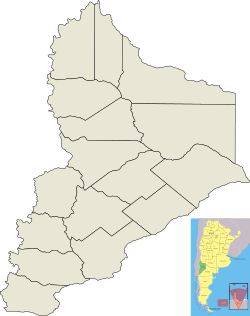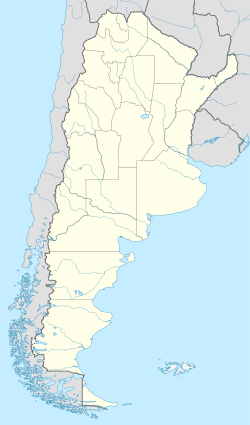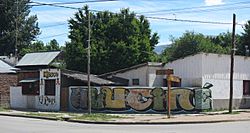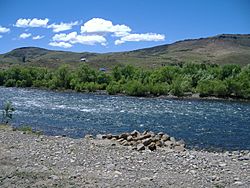Aluminé (town) facts for kids
Quick facts for kids
Aluminé
|
|
|---|---|
|
City and Municipality
|
|
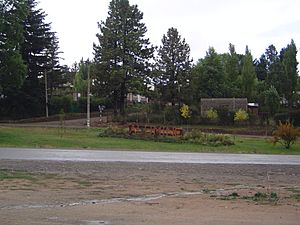 |
|
| Country | |
| Province | |
| Department | Aluminé Department |
| Founded | October 20, 1915 |
| Elevation | 985 m (3,232 ft) |
| Population
(2010 census [INDEC])
|
|
| • Total | 4,861 |
| Time zone | UTC−3 (ART) |
| CPA Base |
B 8345
|
| Area code(s) | +54 02942 |
| Climate | Csb |
| Website | www.alumine.gov.ar |
Aluminé is a cool city and the main town in the Aluminé Department in Argentina. It's located in the west-central part of the Neuquén Province. The town's economy relies on raising animals, using wood from forests, and especially on tourism. It's like a central hub for all the smaller towns and farms nearby.
Aluminé is close to the amazing Andes mountains. This means it has beautiful mountain views, super clear lakes, and fresh streams. You'll also see special local trees like the Araucaria araucana (which is the official tree of the province!), coihue, and mallín plants. It's a fantastic spot for outdoor adventures like trekking, sport-fishing, and rafting.
Contents
A Look Back: Aluminé's History
The name Aluminé comes from the Mapudungun language, spoken by the Mapuche people. It means "shining at the bottom," which probably describes the clear, sparkling waters in the area.
Before the Conquest of the Desert (a time when the Argentine Army expanded into Patagonia), Mapuche communities lived here. They were led by a chief called lonco Reuque Curá. After the Argentine Army arrived, a fort called Paso de los Andes was built. The first settlers came to the area in February 1884.
The first official offices, like the local court and police station, started in a nearby rural area called Ruca Choroy. Aluminé officially became a town on October 20, 1915. This happened because of a provincial rule that reorganized the Neuquén Territory, which is now the Neuquén Province.
By 1913, there were three general stores in the area. People used to travel in groups to Zapala and Neuquén to buy and trade food and other items for their farm products. The town kept growing over the years. In the 1920s, many new businesses opened. The first group to help develop the town and the first elementary school were set up in 1926.
Exploring Aluminé's Geography
This town sits on the left bank of the Aluminé River. It's in the Andean region of western Neuquén Province. Aluminé is about 850 meters (2,789 feet) above sea level. You can reach it by Provincial Route 23. It's about 284 kilometers (176 miles) from Neuquén, the province capital, and 1,340 kilometers (833 miles) from Buenos Aires.
The area around Aluminé is very mountainous. It has clear lakes and streams that add to its beauty. You'll find special trees like Araucaria araucanas and coihue, along with mallín plants. Many cool animals live here too! You might spot mountain lions, pudú (a tiny deer), and South Andean deer. Bird watchers can look for the huge Andean Condor, elegant black-necked swan, and the Darwin's rhea (a type of ostrich). The waters are full of different trouts, like rainbow trout and brown trout, plus perches and other fish.
Aluminé's Climate
| Climate data for Aluminé, Neuquen (1993–2004) | |||||||||||||
|---|---|---|---|---|---|---|---|---|---|---|---|---|---|
| Month | Jan | Feb | Mar | Apr | May | Jun | Jul | Aug | Sep | Oct | Nov | Dec | Year |
| Mean daily maximum °C (°F) | 24.9 (76.8) |
25.3 (77.5) |
22.4 (72.3) |
16.8 (62.2) |
12.7 (54.9) |
8.0 (46.4) |
8.2 (46.8) |
10.6 (51.1) |
13.5 (56.3) |
17.4 (63.3) |
20.0 (68.0) |
23.7 (74.7) |
17.0 (62.6) |
| Daily mean °C (°F) | 15.8 (60.4) |
15.4 (59.7) |
13.1 (55.6) |
8.9 (48.0) |
6.3 (43.3) |
3.4 (38.1) |
3.1 (37.6) |
4.6 (40.3) |
6.6 (43.9) |
9.7 (49.5) |
12.1 (53.8) |
14.8 (58.6) |
9.6 (49.3) |
| Mean daily minimum °C (°F) | 6.7 (44.1) |
5.6 (42.1) |
3.9 (39.0) |
1.0 (33.8) |
−0.1 (31.8) |
−1.2 (29.8) |
−2.1 (28.2) |
−1.4 (29.5) |
−0.2 (31.6) |
1.9 (35.4) |
4.1 (39.4) |
6.2 (43.2) |
2.1 (35.8) |
| Record low °C (°F) | −5.0 (23.0) |
−7.5 (18.5) |
−13.0 (8.6) |
−12.5 (9.5) |
−12.0 (10.4) |
−15.0 (5.0) |
−18.0 (−0.4) |
−17.0 (1.4) |
−11.0 (12.2) |
−6.0 (21.2) |
−9.0 (15.8) |
−3.0 (26.6) |
−18.0 (−0.4) |
| Average precipitation mm (inches) | 18.0 (0.71) |
11.2 (0.44) |
27.3 (1.07) |
60.4 (2.38) |
80.7 (3.18) |
216.8 (8.54) |
140.3 (5.52) |
115.0 (4.53) |
66.2 (2.61) |
56.0 (2.20) |
38.0 (1.50) |
26.1 (1.03) |
856.0 (33.70) |
| Source: Instituto Nacional de Tecnología Agropecuaria | |||||||||||||
People of Aluminé
Who Lives Here?
In 2010, a count showed that 4,861 people lived in Aluminé. This was a big jump of 32% from the 3,720 people counted in 2001. Back in 1970, only 1,239 people lived here. The population grew to 1,640 in 1980 and 2,767 in 1991.
Close to Aluminé, there are also Mapuche communities. Some Tehuelche communities, who were influenced by the Mapuche, also live nearby. Even though they are part of the wider society, they welcome visitors who want to learn about their amazing culture.
Famous People from Aluminé
- Juan Benigar (1883–1950): He was a scientist, anthropologist, and linguist born in Croatia. He moved to Aluminé, started a clothing business, and raised his family there. He wrote books about the lives of local people and settlers in Patagonia, helping everyone understand the community better.
- Félix San Martín (1876–1944): A writer and temporary Governor of the Province. His writings often focused on the history of Neuquén.
Economy and Fun for Tourists
Aluminé is the main town for the Aluminé Department. This means it provides important services for the whole area. The local economy is based on raising animals, using wood from the forests, and especially on tourism. The town has good facilities like hotels, restaurants, gas stations, and grocery stores.
Aluminé's location near the Andes mountains in southern Neuquén Province is perfect. The landscape is full of mountains, lakes, and streams. Aluminé is part of popular tourist routes like the Pehuén route and the Lakes Corridor. The natural beauty here offers many outdoor activities. You can go hiking, trekking, horse riding, sport-fishing, rafting, and kayaking. In winter, you can even go skiing on Batea Mahuida mountain!
Aluminé hosts several fun events every year. On October 20, they celebrate Town Anniversary Day with cultural activities. These include jineteada (a type of rodeo), Argentine folk music, and a fair where local craftspeople sell their goods. Since 1988, they've also held the Provincial Araucaria Festival. This event celebrates the Araucaria araucana, the official tree of the Province, and showcases local products.
You can find beautiful hand-made products by the Mapuche people at the House of Culture's craftsmen fair. The public library, named Juan Benigar after the Croatian pioneer, has an exhibit about his life and work.
See also
 In Spanish: Aluminé (localidad) para niños
In Spanish: Aluminé (localidad) para niños


